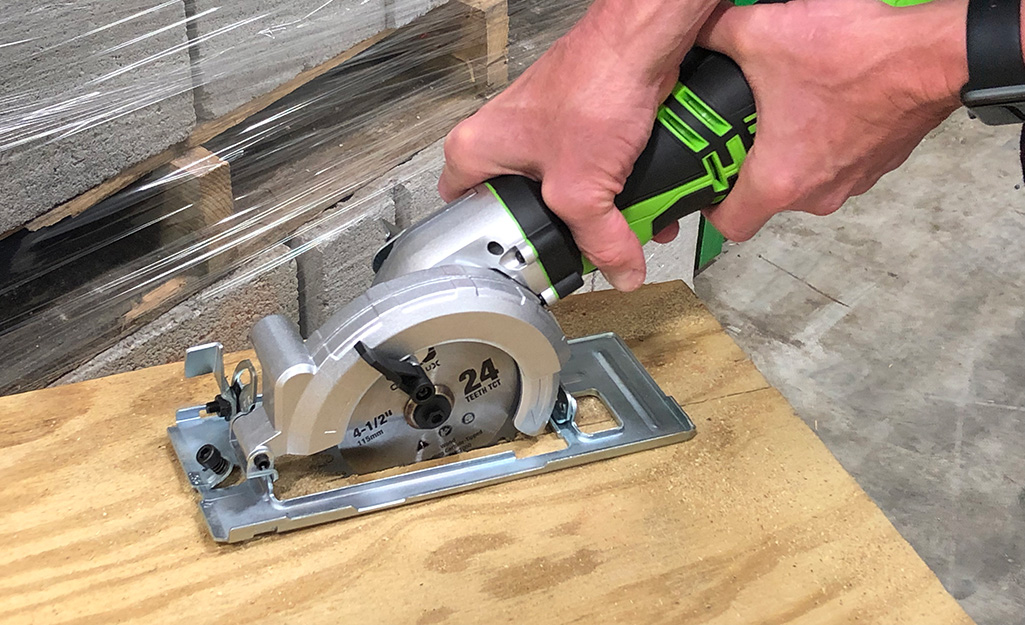To use a circular saw, first make sure that the blade is installed correctly and that the saw is unplugged. Next, adjust the depth of cut by loosening the depth adjustment knob and moving the blade up or down. Once the desired depth is reached, tighten the knob to lock it in place.
To begin cutting, plug in the saw and hold it with both hands. With your dominant hand on the trigger and your other hand on the front handle, position the blade on the line you want to cut. Then, slowly squeeze the trigger and guide the blade along the line.
Remember to keep your fingers clear of the path of the blade at all times.
- Read the instruction manual that came with your circular saw before using it.
- Place the saw on a stable surface, such as a workbench, and ensure that the area around you is clear of any potential hazards.
- Connect the power cord to the saw and plug it into an electrical outlet.
- Adjust the blade guard so that it is flush with the blade.
- Select the appropriate blade for your material and project at hand.
- Install the blade onto the arbor (the shaft in the center of the circular saw), making sure that it is tight enough by tightening the arbor nut by hand and then finishing with an wrench if needed.
- Set your depth of cut by adjusting the blade height lever or knob on your saw until the blade protrudes from the bottom of the shoe (baseplate) to the desired depth of cut—usually about 1/8 inch for most applications.
- To make bevel cuts (cuts not at 90 degrees), loosen the level-adjusting lever or knob and tilt the blade until it reaches the desired angle, then relock the lever or knob securely.
- For crosscuts (cuts made perpendicular to the grain), hold down the fence with one hand while pushing the stock against it with other hand.
- For rip cuts(cuts made parallel to the grain), set the fence at the distance from the blade the equals the width of the sheet good or other stock being ripped.
- Start the circular saw by depressing the trigger switch.
- Guide the Stock through the Blade following the LineaCut.
- When you have reached the end of your cut, release the Trigger Switch and allow the Blade come to a stop before lifting the Circular Saw from your workpiece.

Credit: www.homedepot.com
Can a Beginner Use a Circular Saw?
A circular saw is a tool that can be used to make quick, precise cuts in a variety of materials. While it may seem like a daunting tool for a beginner, with a little practice anyone can learn to use a circular saw safely and effectively. Here are a few tips to help you get started:
1. Choose the right saw for the job. There are different types of circular saws available on the market, so it’s important to select the one that best suits your needs. If you’re only going to be using the saw for occasional DIY projects around the house, then a lower-priced model should suffice.
However, if you plan on using the tool more frequently or for larger jobs, then it’s worth investing in a higher-quality model.
2. Read the manual before you start. This may seem like an obvious tip, but it’s essential nonetheless.
Before using any type of power tool, always take the time to read through the owner’s manual so that you understand how to operate the machine properly and safely.
3. Wear proper safety gear. When using a circular saw, it’s important to wear gloves and eye protection at all times—even if you’re just making small cuts.
Is Using a Circular Saw Hard?
If you’ve never used a circular saw before, the thought of operating one can be intimidating. Rest assured, however, that with a little practice and the proper safety precautions, using a circular saw is relatively easy. Here’s a quick overview of how to use a circular saw:
Before you start cutting, take a few minutes to familiarize yourself with the saw. Read the owner’s manual so that you understand how the saw works and what its various parts are for. Inspect the blade to make sure it is not damaged or dull.
Also check that the blade is installed correctly and tightened securely.
When you’re ready to start cutting, position the piece of wood firmly on your work surface. You may want to clamp it down to keep it from moving around while you’re working.
Then, line up the blade of the saw with your cut line and turn on the power switch. Slowly guide the blade along the cut line, applying steady pressure but allowing the saw to do most of the work. Periodically check your progress by looking at where The Blade Is in relation To The Cut Line And Adjust Accordingly .
Use both hands when operating The Saw And Keep Your Fingers Away From The Blade as much As Possible . Wear eye protection and hearing protection when using power tools like this one.
When you’ve finished making your cut, release The Trigger And Allow The Saw To Come To A Complete Stop Before Setting It Down .
What Should You Use a Circular Saw For?
Assuming you are referring to handheld circular saws, these versatile tools can be used for a variety of tasks including cutting lumber, sheet goods, pipes, and metal. When cutting lumber, a circular saw can rip boards or crosscut them at any angle. It’s also handy for trimming doorjambs and window casings or cutting out sections of damaged drywall.
When working with sheet goods like plywood and particle board, a circular saw is indispensable for making straight cuts. It’s also the best tool for cutting curves in these materials. Just be sure to use a blade designed for cutting laminate flooring or plastic-coated chipboard; regular blades will quickly dull when used on these surfaces.
Pipes can be cut with a circular saw fitted with a metal-cutting blade, but it’s important to support the pipe so it doesn’t sag while you’re cutting it. The same goes for metal siding and roofing, a circular saw is the perfect tool for making clean cuts in these materials, but you’ll need to clamp down whatever you’re cutting to avoid dangerous kickback.
Do I Need a Workbench to Use a Circular Saw?
In short, no – you don’t need a workbench to use a circular saw. However, having a sturdy, level surface to work on will make your life much easier and help you avoid any potential accidents.
If you’re going to be using your circular saw for any serious projects, we highly recommend investing in a good quality workbench.
It doesn’t have to be anything fancy, but it should be made of solid wood or another sturdy material and it should be level. A wobbly workbench is dangerous and makes it very difficult to get accurate cuts with your circular saw.
Another option is to clamp your circular saw onto a table or other flat surface.
This will give you a more stable platform to work from than just holding the saw in your hands. Just make sure that whatever you’re clamping onto is also level – otherwise you’ll still run into the same accuracy issues as if your workbench was wobbly.
HOW TO USE A CIRCULAR SAW FOR BEGINNERS- PART 1
How to Use a Circular Saw Without a Table
If you’re working on a project that requires a lot of cuts, and you don’t have access to a table saw, a circular saw is a great alternative. Here’s how to use one without a table:
1. Place the board you’re going to cut on some sawhorses or another stable surface. Make sure it’s level.
2. Measure and mark your cut line with a pencil. Use a straightedge to extend the line if necessary.
3. Set the depth of your blade by loosening the knob at the back of the saw and adjusting the blade until it’s protruding about an inch from the baseplate. Tighten the knob again to lock it in place.
4. To start your cut, align the blade with your cut line and hold down the trigger. Then, slowly guide the saw along the line as it cuts through the wood. Keep your hands steady and let the saw do all of the work – resist any temptation to force it through faster!
5. a). If you’re making a long, straight cut, you can use both hands to guide the saw for added stability (as shown in photo). Just be extra careful not to let go with one hand while holding down The other hand should be holding behind The front handle for best grip.
b) For curved or irregular cuts, stick with one hand on The trigger and The other hand gripping behind The front handle as close to The blade as possible .
Guide The saw around The curve , resisting any temptation to push too hard or veer off course – letting The blade do all The work .
c) When making plunge cuts – where You need to start The cut in The middle of Your piece of wood–First position The blade on Your mark , then lower It into The wood by depressing The trigger and tilting The saw backward sun till The blade is fully engaged in The wood (See photos).
Conclusion
A circular saw is a powerful tool that can be used to make quick, clean cuts in a variety of materials. When using a circular saw, it is important to use the correct blade for the material you are cutting, and to take care not to overheat the blade. In addition, it is important to keep the saw’s power cord clear of the cutting area to avoid accidents.
Table of Contents

